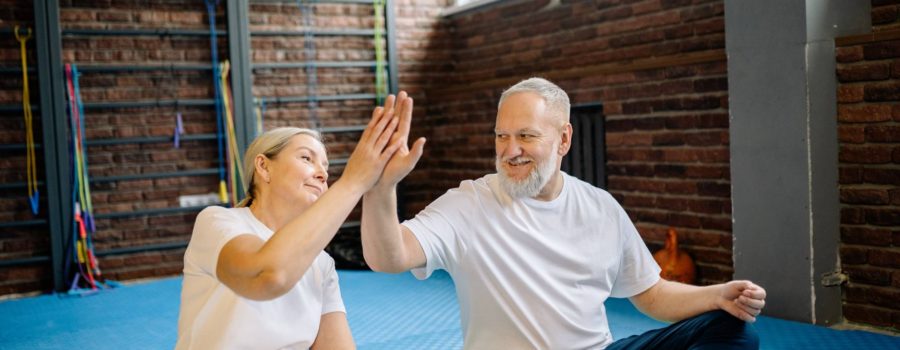I was not an athlete growing up…that simply wasn’t part of our family dynamic. It wasn’t until my mid-20s that I began accompanying some friends to local female-only exercise class, and it didn’t take long for me to become hooked on the feeling of accomplishment and self-confidence it gave me. Despite having to juggle parenting two young boys with a full-time career, “the gym” soon became a non-negotiable part of my daily routine, a habit that continues unabated to this day.
The gym is an essential part of my life. It gives me physical energy, and emotional lift, and the self-confidence to succeed in everything else I do. I quite literally could not live without it, and I don’t think you should have to, either.
Most folks have an on-again-off-again relationship with exercise. Generally, they’ll jump into it after some sort of setback, like a health issue or some sort of advice from their doctor, or maybe they’ll happen upon a photo of themselves on social media and don’t like what they see. Often, they’ll start out like gangbusters, buoyed by the accompanying shot of endorphins and a short-term sense of accomplishment. But it doesn’t take long for the enthusiasm to wain and the effort to fall off.
If this sounds familiar, please don’t fret. The simple fact is that it isn’t too difficult to move your body with some level of effort and regularity, and it’s never too late to start.
But HOW and WHERE to start is the real question, one that is made even more confusing by a multitude of gym options, heavily marketed products, trendy workout routines, and an internet chock full of both misleading advice and unrealistic expectations.
My advice to you is to ignore the noise, keep things very simple, and just get moving! Here are my top tips for establishing a successful exercise routine that becomes part of your life for the long haul.
Adopt a Long Term View
The biggest challenge you’ll face when attempting to jumpstart an exercise routine is to expect results too soon.
On day one you’ll wake up in the morning, look at yourself in the mirror, head to the gym, then go about your day. When you repeat the process the following day, you’ll notice that the mirror’s reflection remains the same.
After a month’s worth of hard work, you’ll find yourself once again staring begrudgingly in the mirror looking for something – anything – to offer concrete evidence that all your time in the gym has produced some results; but you still don’t look anything like that Photoshopped fitness model you’ve been following online.
This is when most people get frustrated and start falling off the wagon.
Attempting to view progress through a short-term lens is the number one reason why most people fail. Don’t expect that you’re going to transform your body overnight…it’s simply not going to happen. Instead, be satisfied that the increased energy you’re feeling and the degree of self-satisfaction you’ve achieved is benefit enough.
You are happier, healthier, more patient, and move through your life with more confidence than before. All things equal, you’re likely to live longer and maintain vitality later in life. Maybe someday you’ll see an extra bump on your bicep or a slight ripple on your abs where the fat used to be. Or maybe not. It doesn’t matter, ‘cause you’re a way better person than you were before.
Consistency is Key
You’ve gone to the gym and nailed a killer workout. Great! But then you wake up the next morning feeling tired and maybe a little sore, and you rationalize skipping a day. NOT great!
I’ve stated multiple times already that fitness needs to be a non-negotiable part of your daily routine, but life is full of challenges that can easily upend you. Physical problems, family concerns, work commitments, heck even the weather can throw a monkey wrench into your gym schedule. Don’t let it!
Financial folks will advise, “always pay yourself first”. This is great advice, and the gym is no different. Schedule your workouts in advance and stick to your schedule. Plan everything else in your life around it. If something happens and you have no choice but to miss a workout, that’s fine. But don’t let it happen two days in a row.
For beginners, I have found that moving your body 4-5 times each week is the optimum cadence. Fewer than that and the results are muted, and more than that can be a chore. If you can schedule 4-5 workouts each week and stick to that schedule, you’re way ahead of the game.
Find your “Gym”
I tend to use the term “gym” somewhat generically. I have an actual gym membership and really enjoy the opportunities that affords me, but your “gym” might be something entirely different.
Maybe it’s a walking, hiking, or biking trail at a local park. Maybe it’s a yoga studio or local lap pool. Maybe it’s a spare room in your home with some basic exercise equipment. Or, maybe it’s something as simple as an exercise mat.
Going to the “gym” doesn’t need to involve packing a bag and driving to a physical destination. It can be much more convenient than that and can often get done without leaving the house. But it does need to get done, and it needs to get done consistently.
Don’t Resist the Resistance Training
As it turns out, loss of muscle mass contributes as much to the aging process as anything else. In fact, there may be nothing more important to staving off the effects of aging than maintaining or adding some muscle to your frame.
I’m not saying you should be striving to look like a modern version of Arnold Schwarzenegger, but I am saying that building functional strength should be a primary goal of your exercise routine if aging gracefully is something that appeals to you.
The stronger you are the better your balance will be, and the less likely you are to experience a fall or injure yourself performing routine daily tasks. The stronger you are, the better your posture will be, and the healthier your bones will stay as you age. Additionally, adding some muscle mass will effectively increase your metabolism, making it easier to maintain a healthy bodyweight.
There are more benefits to adding muscle mass and overall functional strength than I could ever articulate in a single article. Suffice it to say, you should do yourself a favor and add some resistance training to your exercise routine.
Resistance training can be daunting to those who haven’t done much of it, but it doesn’t have to be. Basic bodyweight exercises such as push-ups, pull-ups, sit-ups, and simple deep-knee bends can go a long way, and you can get yourself a world-class strength workout with a basic set of light-to-medium dumbbells. While I’ll have to stop short of recommending strength training workout routines in this article (more on this later), I would suggest doing some strength work at least once per week.
Take Action!
If you’re someone who has struggled to integrate a consistent exercise routine into your life, let this serve as a reminder that – regardless of your age or physical condition – there’s no better time than the present to begin. So, whip out a paper and pen and write down a plan. Keep it simple, resist the urge to consult “Coach Google” for all sorts of complicated workouts, and for God’s sake don’t compare yourself to online fitness “influencers”.
Instead, just figure out how and when you can squeeze in time to move your body 4-5 times per week and resolve yourself to sticking to your plan. Then, after you’ve proven to yourself that you can stick to it – let’s say, for a month or more – then you can begin adding some complexity to your workouts.
This is a marathon, not a sprint. Just get started and keep it going. Before you know it, you’ll find yourself wondering how you ever lived without exercise, just like the life-changing realization I came to over 3 decades ago.
Keep an eye on my blog for additional content on this topic and suggested workouts and keep me informed of your progress. As always, if you ever need help planning for the care of an elderly loved one, know that One Life Consulting will be there for you.





